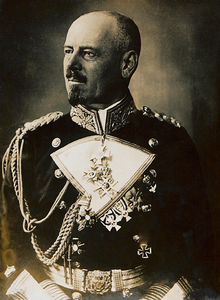Franz von Hipper | |
|---|---|
 Von Hipper in 1916 | |
| Born | 13 September 1863 Weilheim in Oberbayern, Bavaria, German Confederation |
| Died | 25 May 1932 (aged 68) Othmarschen, Weimar Republic |
| Allegiance | |
| Service/ | |
| Years of service | 1881–1918 |
| Rank | Admiral |
| Commands held |
|
| Battles/wars | |
| Awards | See below |
Franz Ritter von Hipper (13 September 1863 – 25 May 1932) was an admiral in the German Imperial Navy (Kaiserliche Marine). Franz von Hipper joined the German Navy in 1881 as an officer cadet. He commanded several torpedo boat units and served as watch officer aboard several warships, as well as Kaiser Wilhelm II's yacht SMY Hohenzollern. Hipper commanded several cruisers in the reconnaissance forces before being appointed commander of the I Scouting Group in October 1913.
He is most famous for commanding the German battlecruisers of the I Scouting Group during World War I, particularly at the Battle of Jutland on 31 May – 1 June 1916. During the war, Hipper led the German battlecruisers on several raids of the English coast, for which he was vilified in the English press as a "baby killer". His squadron clashed with the British battlecruiser squadron at the Battle of Dogger Bank in January 1915, where the armored cruiser Blücher was lost. At the Battle of Jutland, Hipper's flagship Lützow was sunk, though his ships succeeded in sinking three British battlecruisers. In 1918 he was promoted to succeed Admiral Reinhard Scheer as commander of the High Seas Fleet.
After the end of the war in 1918, Hipper retired from the Imperial Navy with a full pension. He initially lived under an alias and moved frequently to avoid radical revolutionaries during the German Revolution of 1918–1919. After the revolution settled, he moved to Altona outside Hamburg. Unlike his superior, Reinhard Scheer, he never published a memoir of his service during the war. Hipper died on 25 May 1932. The Kriegsmarine commemorated him with the launching of the heavy cruiser Admiral Hipper in 1938.